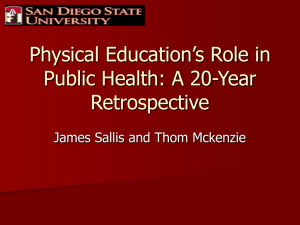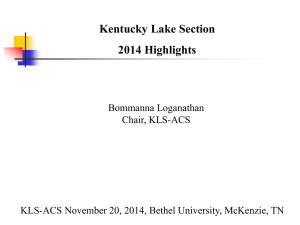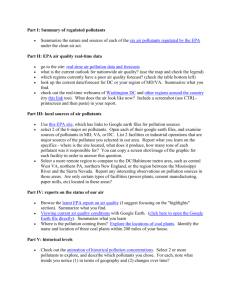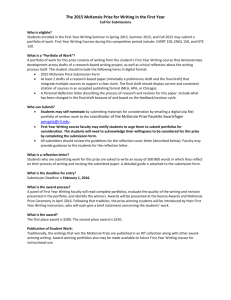National Environmental Public Health Tracking Network
advertisement
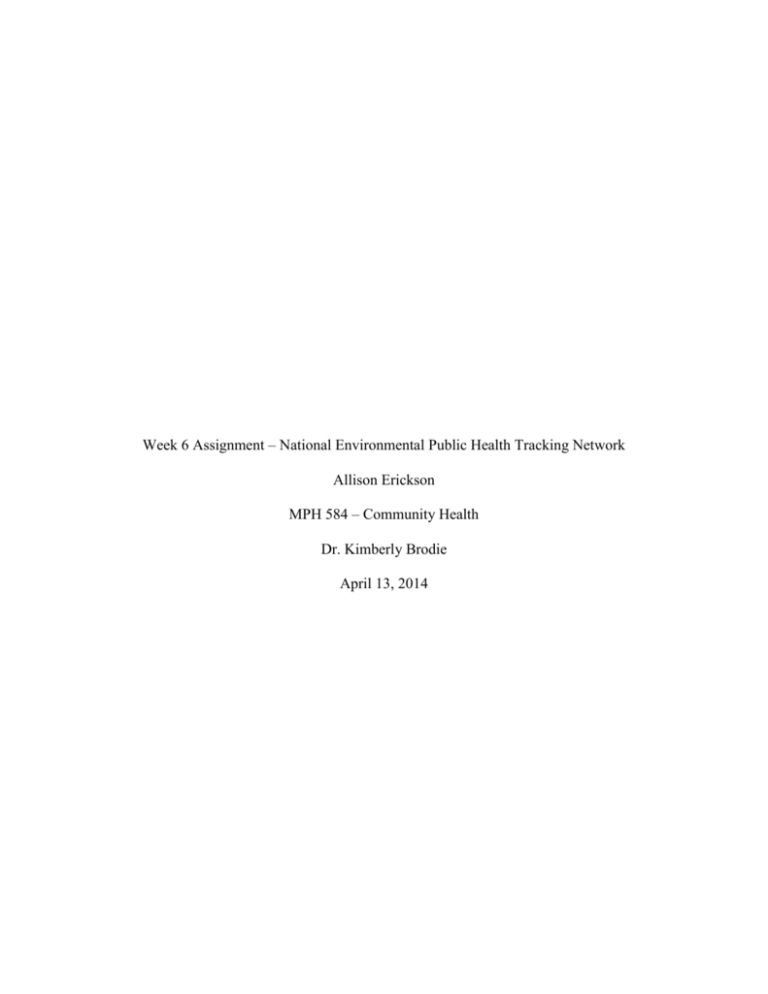
Week 6 Assignment – National Environmental Public Health Tracking Network Allison Erickson MPH 584 – Community Health Dr. Kimberly Brodie April 13, 2014 1 1. List select sources and types of air pollutants (choose 3-5), and agencies involved in providing regulations and services. There are both indoor and outdoor air pollutants. Sources of these pollutants include combustion by-products like carbon monoxide, nitrous dioxide, and particulates, as well as ground-level ozone gases and sulfur dioxide. Combustion by-products come from ash or soot used in fireplaces, wood stoves, gas ranges or engines, candles, and improperly maintained gas furnaces (McKenzie, Pinger, & Kotecki, 2012). Also, radon and environmental tobacco smoke, or secondhand smoke, can be sources of indoor air pollutants. Radon is a gas that is not seen, smelled, or tasted, making it extremely dangerous. The gas is naturally occurring, but will seep through cracks, home foundations, rocks, and water being exposed to humans (McKenzie et al., 2012). Environmental tobacco smoke occurs when someone inhales the smoke exhaled after inhaling a cigarette, pipe, or cigar, as well as breathing in the smoke created at the end of the tobacco product. The Clean Air Act, developed in 1970, is the Environmental Protection Agency’s (EPA) authorization to regulate and monitor indoor air quality in homes, business, and other indoor spaces (EPA, 2014). Although the EPA (2014) sets the limits for the regulatory levels of the pollutants, much of the action to reduce or improve the numbers comes from state and local government officials. Continuing, the Centers for Disease Control (CDC, 2014) works diligently to protect the air inhaled by everyone. Specifically, the CDC (2014) has campaigns and initiatives around the United States urging for stricter tobacco laws to prevent unnecessary environmental tobacco smoke. 2. List the major types of indoor air pollutants, exposure sources, and prevention strategies. The major types of indoor air pollutants include biogenetic pollutants, combustion byproducts, and volatile organic compounds (VOCs). Biogenetic pollutants can include toxins, 2 viruses, bacteria, molds, pollens, insect waste, and animal dander (McKenzie et al., 2012). These pollutants usually enter the human body through inhalation. “People can minimize exposure to these pollutants by controlling the relative humidity level in a home or office; a relative humidity of 30% to 50% is generally recommended for homes” (McKenzie et al., 2012, p. 437). Removing standing water, wet or water-damaged home materials, and having appropriate inspectors come to manage the problem are also ways to prevent these pollutants. Combustion by-products include carbon monoxide, nitrous dioxide, and sulfur dioxide gases and particulates from ash or soot. Fireplaces, wood stoves, kerosene heaters, candles, incense, secondhand smoke, and unmaintained gas furnaces are sources of exposure. To prevent the exposure to these pollutants houses are encouraged to have carbon monoxide detectors placed in the house and maintained to trigger an alarm if the level of carbon monoxide is dangerous. Other prevention strategies are to properly clean and maintain fireplaces and furnaces on a yearly or bi-yearly basis to reduce the amount of byproduct and soot gathering. VOCs are vapors that exist when the range of air pressure and temperature are elevated. “Sources of VOCs include construction materials, structural components, furnishings, cleansers and solvents, insectides/pesticides, electrical equipment, and combustion of wood and kerosene” (McKenzie et al., 2012, p. 438). Increasing ventilation, using a dehumidifier and air conditioning for controlling humidity, as well as keeping temperatures at moderate levels are all ways to reduce the harmful emissions creating these pollutants. Also, decreasing the use of harmful chemicals, especially when cleaning or gardening, can greatly reduce one’s exposure to VOCs. 3. Identify three categories of pesticides, and hazards to human health from exposures in both communities and occupational settings. First, insecticides and herbicides cause hazards to human health when they are consumed orally, inhaled, or when in contact with one’s skin. Most of the hazards to adults is when the 3 chemicals are handled poorly or used carelessly. For example, a farmer may believe that he or she knows what to do with an herbicide and does not wash his or her hands after being in the fields spraying. After he or she begins to eat something, the chemical is now being ingested from the hands. This is also the case if produce from fields that use insecticides or herbicides are consumed without washing properly first. Occupationally, many individuals who manage agriculture business across the United States and world use English as a second language. Rarely, the information for safety on these products is often written in English, creating a barrier for the employees. This is a hazard in itself, entering a field after being sprayed because the employee could not read the warning can create danger for him or her and their families. Finally, fungicides are pesticides preventing the growth and development of fungi and their spores on plants (The American Phytopathological Society (APS), 2014). These pesticides are used before a plant becomes infected with fungi to increase the plants productivity. As aforementioned, direct and indirect contact with this type of pesticide can cause bodily harm on the skin, digestively, and respiratory system if not handled properly. The harm done to communities from all three types of pesticides is widespread. These chemicals can create runoff into local streams, rivers, and lakes that individuals swim in, drink from, or grow crops. Also, the chemical particles enter the air which can travel and be inhaled by a number of different communities, impacting respiratory health. 4. Why are pesticides utilized? Describe the hazards of pests, and vector-borne diseases. Pesticides are utilized for the purpose of killing pests. McKenzie et al. (2012) explains, “Many of these pesticides are used in agriculture, where it is estimated that pests destroy about 40% of the food crop before it reaches the marketplace” (p. 453). By not using these chemicals, the agriculture system could decrease by as much as 30% (McKenzie et al., 2012). Pesticides are used for target and non-target organisms to protect a crop. Therefore, the hazards of pests can 4 really be hazards to the livelihood and success of farmers across the world. Vector-borne diseases are hazardous because they can infect humans and animals. These diseases are typically found in mosquitos, ticks, and fleas. When there is waste-water or when there is inadequate drainage of rainwater, mosquitos will flourish by multiplying, creating higher risk of vectorborne diseases, like the West Nile Virus. 5. Identify strategies for preventing foodborne illnesses. Strategies for preventing foodborne illnesses include, washing hands and surfaces often, avoiding cross-contamination, cooking food to proper temperatures, and refrigerating promptly. It is recommended to wash hands for 20 seconds under warm water with soap before and after handling food, after using the bathroom, changed diapers, or handling pets. Washing cutting boards, dishes, utensils, and countertops is important, as well. Additionally, washing and scrubbing firm-skin fruits and vegetables prior to use will help reduce foodborne illness (McKenzie et al., 2012). Separating poultry, seafood, eggs, and raw meat from other foods is helpful. “Never place cooked food on a plate that previously held raw meat, poultry, seafood, or eggs” (McKenzie et al., 2012, p. 455). Red meat is recommended to cook to temperature of at least 145 degrees and poultry is recommended to cook to 165 degrees, both taken in the inner most part of the meat. The recommended cooking temperature for fish is 145 degrees. Finally, keeping foods that need refrigeration at a constant 40 degrees will reduce foodborne illness. McKenzie et al. (2012) recommends, “Never let raw meat, poultry, eggs, cooked food, or cut fresh fruits or vegetables sit at room temperature more than two hours before putting them in the refrigerator or freezer” (p. 455). 6. Describe forms and management of hazardous waste, including e-waste and solid waste. Hazardous waste is solid waste with properties that can be dangerous or harmful to human health and the environment (McKenzie et al., 2012). Solid waste, therefore, is garbage, 5 sludge, refuse, or other discarded solid materials that can be traced to agriculture, mining and gas production, households, businesses, and institutions. Solid waste management is the, “collection, transportation, and disposal of solid waste” (McKenzie et al., 2012, p. 457). One of the most desirable approaches to managing solid waste is through source reduction. “Examples of solid waste source reduction include not buying or using such throwaway products as paper towels and disposable diapers and minimizing packaging associated with groceries and carryout foods” (McKenzie et al., 2012, p. 459). Recycling is also a helpful way manage solid waste by repurposing, reusing, and reducing the amount of products used on a daily basis. Electronic waste, or e-waste, is the disposal of electronic products. E-waste is hazardous because there are great amounts of lead and other heavy metals found in the devices. “When electronics are not properly disposed of or recycled, these toxic materials can be released into the environment through landfill leachate or incinerator ash…” (McKenzie et al., 2012, p. 458). To reduce the amount of e-waste, agencies recommend donating electronics or recycling the products using local, state, or national agencies. 7. Define and discuss the following: Brownfields, Superfund sites, and storage tanks for waste in communities. “A brownfield is a property, the expansion, redevelopment, or reuse of which may be complicated by the presence or potential presence of a hazardous substance, pollutant, or contaminant” (EPA, 2012). Brownfields use abandoned industrial plants, factories, commercial worksites, gas stations, and junkyards to create jobs, improve and protect the environment, and take development pressure off open land. “A Superfund site is an uncontrolled or abandoned place where hazardous waste is located, possibly affecting local ecosystems or people” (EPA, 2014). These Superfund sites inform residents where hazardous waste is located, protecting them from contamination. Also, Superfund sites seek to remove the hazardous waste to create a 6 cleaner environment. Underground storage tanks are used across the United States to store hazardous substances and petroleum (EPA, 2013). If these underground storage tanks begin to leak, the water quality entering and being used by communities around the storage tanks could be threatened. 8. Define and describe the implications of CERCLA to environmental health. The Comprehensive Environmental Response, Compensation, and Liability Act (CERCLA) was passed by Congress in 1980. This Act was in response to, “the public’s demand to clean up leaking dump sites” (McKenzie et al., 2012, p. 462). Continuing, the Act, also known as Superfund, established a national priority list (NPL) of hazardous waste sites across the country, while providing funds to clean up the sites. Since 1980, there have been 45,826 contaminated sites placed in the database for NPL selection. The CERCLA has provided more than $15 billion for cleanup across NPL sites, equaling about one billion dollars per year (McKenzie et al., 2012). Implications of CERCLA to environmental health are that the Act has helped reduce environmental pollutants and hazards that pose direct risk to communities surrounding the hazardous sites. Without the CERCLA, many communities would be facing long-term environmental health risks, as well as physical health risks. 9. Define and describe social determinants of health, and the role of community and environmental justice. Social determinants of health are, “the conditions in which people are born, grow, live, work and age. These circumstances are shaped by the distribution of money, power and resources at global, national and local levels” (World Health Organization (WHO), 2014). Hazards seen at the sociological level can have a great impact on population growth. McKenzie et al. (2012) indicate that 80 percent of the world’s population lives in less developed countries. The rate at which the world’s population is growing has environmentalists concerned. This concern is that resources will continue to become unsustainable, which will impact the quality of 7 life and health of communities around the world. “Most experts agree that the world population is approaching the maximum sustainable limit” (McKenzie et al., 2012, p. 472). Therefore, less sustainability means more waste and environmental damage. As aforementioned, with 80% of the world’s population living in less developed countries, this also means that most of the world is faced with negative social determinants. Errath (2013) explains that with the millions of people living in the slums of India, there are tons and tons of waste that the people are living on. “Waste from manufacturing plants and garbage has built up for many years in these slums and severely ruined the environment. This damage is irreversible and these large tracts of land will be unusable if these slums go away” (Errath, 2013). The environment that the people living in slums live in and on are creating poor health outcomes for humans, plant life, and animals. Therefore, environmental justice needs to be served to educate and bring awareness about the damage being done to these communities across the world. Just because a family in India may have lived in the slums for generations, that does not mean they do not deserve quality environments for healthy living. Additionally, environmental justice in this case also means that the people of India deserve the same deal of environmental protection from hazards as those that do not live in slums. 10. What is the role and responsibility of FEMA in environmental disasters? Cite an example. The Federal Emergency Management Agency (FEMA), “leads efforts to prepare communities around the United States for all hazards and manages federal response and recovery efforts following any national incident…” (McKenzie et al., 2012, p. 474). FEMA assists communities following fires, floods, earthquakes, tornados, landslides, tsunamis, wildfires, winter storms, and terrorism. In response to Hurricane Sandy in 2012, FEMA utilized local and national response agencies like the American Red Cross to provide assistance to those affected 8 by the hurricane. There were incident management teams deployed to impacted areas to delegate tasks, create housing options, and utilize community resources. In essence, the role of FEMA in any environmental disaster is to organize, delegate, and assist when needed (FEMA, n.d.). There are multiple agencies and organizations locally and nationally that also step in to assist during such disasters, so FEMA plays the role of administrator in making sure the communities affected by the disaster are taken care of safely and efficiently. 11. Cite 3 examples of unintentional injuries, and agencies that plan, respond, and create prevention strategies for these injuries. Three examples of unintentional injuries include motor vehicle crashes, falls, and poisoning. The National Highway Traffic Safety Administration (NHTSA) is an agency that surveys, responds, and creates prevention strategies to prevent motor vehicle injuries and crashes. Also, the United States Consumer Product Safety Commission aids in creating childsafe prescription drug caps to prevent unintentional poisoning. Finally, the Centers for Disease Control and Prevention aims to create plans and prevention strategies to reduce the numbers of unintentional injuries nationwide. 12. Cite community approaches and models (3 examples for intentional and unintentional injuries). Community approaches to prevent unintentional injuries begins with education. One way this is done is through taking drivers education classes both in a classroom and behind the wheel to practice safe driving skills. Regulation is another way to prevent unintentional injuries. An example of this is through speed limits, protecting both those driving, as well as pedestrians. Also, automatic protection, like child-safe caps on prescription drugs, is another way to prevent unintentional injuries. Intentional injuries can be prevented also through education. One such 9 way is to provide basic communication and problem-solving skills in schools across the country. By learning how to solve a disagreement or communicate a problem, there would be less opportunity for engaging in violence (McKenzie et al., 2012). Finally, child maltreatment is another form of intentional injury. To prevent this from occurring, there must be a system of timely reporting and referral for state child protective services. 13. Discuss the types of injuries that frequently occur in the workplace and describe their occurrence with regard to person, place, and time. Unintentional injuries in the workplace can be both fatal and non-fatal. Fatal work-related injuries occur during highway accidents, falls, homicides, and exposure to harmful substances or environments (McKenzie et al., 2012). The majority of non-fatal injuries in the workplace occur after an individual has been struck by an object or equipment. “Approximately 57% of all injuries/illnesses were categorized as sprains and strains or lacerations, punctures, amputations, or avulsions” (McKenzie et al., 2012, p. 527). Workplace fatality rates increase as one ages. However, teenagers are still at risk for being injured on the job. Males also account for nearly two-thirds of all injury and illness cases with days away from work, where females have much lower rates of fatal work-related deaths than men do (McKenzie et al., 2012). The reason for this data is because men are often employed in more dangerous working environments. Continuing, those living in communities where income is lower, have significantly higher rates of death than those in higher-income communities (McKenzie et al., 2012). Rural states have higher workrelated fatality rates due to greater use of machinery, falling objects, electric current, and explosions. Farm machinery deaths are higher in the north-central part of the United States, where non-machinery deaths are higher in mountainous regions. During the summer months, there is an increase in machinery, falling objects, electrical current, and explosion-related deaths 10 due to increase in agriculture work. Also, more of these deaths occur on the weekdays than on the weekends. 14. List and briefly describe several occupational safety and health programs for the workplace, and put occupational programs in historical context. Disease prevention programs focus on controlling occupational diseases that one might contract from exposure in the workplace. Worksite health promotion (WHP) programs aim to improve the health and well-being of employees through behavior and lifestyle changes. These programs aim to reduce employee absenteeism, increase productivity, and improve employee morale (McKenzie et al., 2012). Also, employee assistance programs (EAPs), “assist employees who have substance abuse, domestic, psychological, or social problems that interfere with their work performance” (McKenzie et al., 2012, p. 548). EAPs were at many workplaces prior to WHP programs as a way to provide secondary and tertiary prevention. WHP programs aim to provide primary prevention techniques. 15. Explore the National Environmental Public Health Tracking Network. Identify an issue of your choice in the community where you live. View the maps and discuss this tool as a resource for the community chosen, and identify the connection to chronic disease, using this tool. The issue I choose to explore was the smoking prevalence of those ages 18 to 24 in Minnesota during 2012. After reviewing the results, the total number of smokers in that age group was around 100,800 people. Minnesota is about in the middle compared to other states and smoking prevalence. In connection to chronic disease, I examined the number of hospitalizations from heart attacks in 2010 in Minnesota for those 35 to 64 years old. The tool gathered that there were 3,282 hospitalizations in 2010 due to heart attacks. There is a clear link between cardiovascular disease and tobacco use. Thus, there can be estimations that as the rate of tobacco use either decreases or increases over time in the state, which should impact the amount of heart 11 attacks reported in the next 10 years with the population studied for tobacco use. (National Environmental Public Health Tracking Network, 2013) 16. Choose one criterion pollutant that the EPA monitors. Find one incident in the literature where this pollutant was problematic (in a community or workplace). a. Identify the source of this pollutant (primary or secondary) and the issues this created in the community/workplace affected. Carbon monoxide poisoning has been shown to increase during snowstorms and power outages, according to Johnson-Arbor, Quental, and Li (2014). “Snow drifts may block home heating vents, causing indoor accumulation of carbon monoxide in homes with non-electric heating sources” (Johnson-Arbor et al., 2014, p. 481). The researchers sought to discover why there was an increase in carbon monoxide poisoning after a seven year old girls was poisoned in Massachusetts following a large snow storm. During this snow storm, the family’s heating vents were blocked, causing the young girl to inhale a deadly amount of carbon monoxide. After substantial snowfalls in Connecticut in both 2011 and 2013, Johnson-Arbor et al. (2014) discovered that the numbers of carbon monoxide poisoned patients increased at local hospitals. Therefore, Johnson-Arbor et al. (2014) believe that communities that are impacted by large amounts of snow drifting to block heat vents, cars running in garages to warm up, and the use of portable heaters using generators, are at risk of increased carbon monoxide exposure. b. Discuss the cost to human health and the financial impact from the pollutant and/or mitigation efforts. The cost to human health is that carbon monoxide is difficult to conclude because the gas is odorless and colorless. Exposure to the gas over prolonged periods of time creates sleepiness, which, if not discovered in a timely manner, can lead to death. Financially, the cost can be devastating. Using services to clear the carbon monoxide, as well as paying for hospital costs 12 impacts an entire community. As mentioned, carbon monoxide is unnoticeable through our senses, which makes it even more difficult to catch in a timely manner. This means the financial costs will be higher. c. Describe whether or not this was an anthropogenic event or naturally occurring, and whether or not there any preventive steps that could have been taken. This event could be both anthropogenic and naturally occurring. First, when someone leaves a vehicle running in the garage with the garage door closed, the carbon monoxide poisoning can occur because of the person’s decision. However, in the case of blocked heating vents due to a large snowfall, that could be considered naturally occurring. The carbon monoxide needed a place to be released, but was being blocked by a naturally occurring event. Nonetheless, in the case of being in a community where substantial snowfalls are common, communities can ensure heating vents are clear of snow, let the vehicle run outside of the garage, keep careful watch of portable heaters running off of generators, and most importantly, invest in one or more carbon monoxide detectors. d. Discuss what you would do or have done to alter the situation this created (or the response). In this situation and with the new knowledge that carbon monoxide deaths increase during substantial snowfalls, I would have urged news channels to promote clearing heat vents, as well as investing in carbon monoxide detectors. If the community was of low socioeconomic status, I would encourage community leaders to support giving detectors free of charge or at a discounted rate to prevent unnecessary death during snowstorms. 13 References Centers for Disease Control and Prevention. (2013). National environmental public health tracking network. Retrieved from: http://ephtracking.cdc.gov/showHome.action Centers for Disease Control and Prevention. (2014). Secondhand smoke. Retrieved from: http://www.cdc.gov/tobacco/basic_information/secondhand_smoke/ Environmental Protection Agency. (2012). Brownfields and land revitalization. Retrieved from: http://www.epa.gov/brownfields/basic_info.htm#plan Environmental Protection Agency. (2014). Superfund sites where you live. Retrieved from: http://www.epa.gov/superfund/sites/ Environmental Protection Agency. (2014). The plain English guide to the Clean Air Act. Retrieved from: http://www.epa.gov/air/caa/peg/cleanup.html Environmental Protection Agency. (2013). Underground storage tanks. Retrieved from: http://www.epa.gov/swerust1/aboutust.htm Errath, T. (2013, August 13). Pollution in India’s slums. The Earthly Report. Retrieved from: http://www.earthyreport.com/site/pollution-in-indias-slums/ Federal Emergency Management Agency. (n.d.) Hurricane Sandy: Timeline. Retrieved from: http://www.fema.gov/hurricane-sandy-timeline Johnson-Arbor, K.K., Quental, A.S., & Li, D. (2014). A comparison of carbon monoxide exposures after snowstorms and power outages. American Journal of Preventative Medicine, 45(5), 481-486. McKenzie, J.F., Pinger, R.R., & Kotecki, J.E. (2012). An introduction to community health (7th ed.). Sudbury, MA: Jones and Bartlett Learning. The American Phytopathological Society. (2014). What are fungicides? Retrieved from: https://www.apsnet.org/edcenter/intropp/topics/Pages/Fungicides.aspx World Health Organizations. (2014). Social determinants of health. Retrieved from: http://www.who.int/social_determinants/sdh_definition/en/
